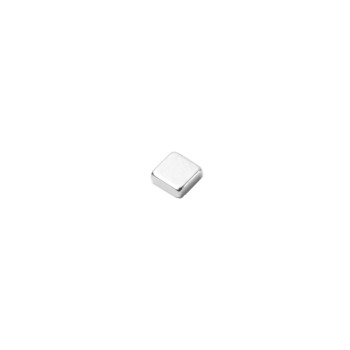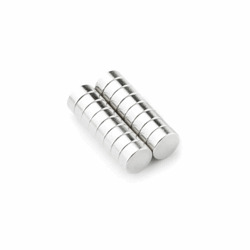What is a N52 magnet?
In this article, we’ll be talking about N52 magnets - and what a N52 magnet is. If you’re just a little interested in magnets, you’ve probably heard about the type of magnets called Neodymium, including the n52, which is the one we’re gonna discuss.
What is an N52 magnet? An N52 magnet is the highest grade of neodymium magnet currently available. Neodymium magnets are the most commonly used type of rare-earth magnet. Neodymium magnets is a permanent magnet, which is made from an alloy of neodymium, iron, and boron.
That was the short and simple answer to what an N52 magnet is. If you’re interested in learning more about n52 magnets, what the difference between an n35 and an n52 magnet is, how much weight an n52 magnet can hold, what the N rating on a magnets is, what an n52 magnet is used for, and last but not least, what the difference between temporary and permanent magnet is.
Enjoy!
Strongest member of the rare earth magnet family
Is mentioned before, an N52 magnet is the strongest member of the rare earth magnet family, and the most powerful permanent magnet currently available in the world. The rare earth family includes, as the name indicates, magnets that are made from different rare earth elements.
Neodymium magnets are also called NdFeB or NIB magnets. The reason for the names is the way they’re composed. Mainly, they’re composed of neodymium, iron, and boron. Neodymium magnets, including the N52 magnet, are a fairly new invention, which quite recently became affordable for everyday use.
N rating on magnets
All neodymium magnets I rated with an “N” following with a number, often between "35" and “52”. The number is an expression that determines the maximum weight of which they can be magnetized. The number is, besides an indicator of the magnets strength, an expression of the strength measured in Megagauss Oersted.
This simply means that an n52 magnet has a maximum energy product of 52 Megagauss Oersted, an n50 magnet has a maximum energy product of 50 Megagauss Oersted, and so on.
“52” is, as mentioned, the highest number of the N rating, which also means that it is the strongest.
Use of neodymium magnets
Neodymium magnets are a relatively new invention but have already replaced both Alnico and ferrite magnets in many applications of modern technology. It’s mostly used in applications, where a strong and permanent magnet is needed.
The neodymium is frequently used because their massive strength allows fabricants to use smaller and lighter magnets for many different applications. To mention a few, neodymium magnets are used for:
- Head actuators for hard disks
- E-cigarette firing switches
- Locks
- Speakers and headphones
- Speakers on phones
- Electric Motors
- Electric generators for wind turbines
The impressive strength of the neodymium magnets has also lead to some new applications, where magnets are not seen before. For example as jewelry clasps and magnetic building sets. Neodymium magnets have been used as a part of the closing mechanism of some parachute equipment.
How much weight can an n52 magnet carry?
To determine exactly how much an n52 magnet can carry, you will have to use a magnetic calculator. Determining how much a magnet can carry, requires some info about the size of the magnet.
There are different ways to determine the strength of a magnet, but it all depends on how you define strength. The most common measurements are pulled force and strength of the magnetic field.
Pull force is the measurement that determines how much power you have to use in order to remove the magnet from the object. A surface made of steel, for example. You usually measure this type of strength in either pounds, kilos or newtons.
Magnetic field strength determines the magnets field strength and direction towards a point near the magnet. The magnetic field strength is measured in Gauss or Tesla and is influenced by both size, shape and of course grade of the magnet.
Related products - What is a N52 magnet?
How magnets work
Now that we have covered what aa n52 magnet is, what it can be used for, and how to determine the strength of a magnet, let us take it back a notch and discuss how magnets even work.
The best way to answer it is for yourself to do a minor experiment. Try taking a magnet and some needles (the kind you use for sewing), and hold the needles against the magnet. The stronger the magnet is, the better the experiment will work.
Now, when you remove the needles, you will actually have created a magnet in the form of each tiny needle. For example, if you touch the needles with a screwdriver, the needles will stick to it.
Needles are made of steel, and steel is made of billions of atoms, which each have a tiny bit of magnet within it. The atoms the steel is made of will stick together in domains, which is a kind of group.
The atoms within a domain will all point in the same direction, making the group of atoms behave just like a very small magnet, kinda like one used for toys. This is also why the needle within a compass always will point towards the north because it automatically will line itself with the magnetic field of the earth.
When the needle is produced out of a piece of steel, the domains will usually get messed up and point in various directions, which cancels the magnetic effect. But, when you bring it close to a magnet, the domains will once again point in the same direction, which makes the magnetic effect return.
The reason for this is that magnets attract magnets, forcing them to point the same way, which creates another magnet. So you might say that magnets create other magnets because it forces the domains within the steel to point in the same way.
6 useful facts about magnets
Since you’re still with us, I guess you have an interest in magnetics and magnets, just like us. Therefore, we have sampled 6 interesting facts about magnets, which we believe that every magnetic enthusiast will appreciate. Here they are:
- A magnet contains two ends called poles, where one of them is referred to as a north pole, and the other, you might already have guessed it, south pole.
- The two different poles attract each other, but, two of the same poles will reject each other. You might have discovered this if you have ever played with magnets. One of the sides attracts each other and is a struggle to pull apart, while other sides are nearly impossible to get together.
- A magnet creates an invisible magnetic field.
- The north pole of a magnet will always point towards the north pole (The north pole of the earth), and the south pole will always point towards the south pole. This is why there is a needle within a compass, so you always can know which direction is north. The reason for this is that our earthworks like one giant magnet because it contains so large amount of magnetic materials within it.
- You can always get more magnets if you have one magnet. For example, if you cut a magnet in half, the magnet will become two magnets. If you cut it in half, the magnet will create another south and north pole, making it two magnets.
- A magnet can create a magnet within unmagnetized materials. All you have to do is simply holding it near a magnet. The existing magnet will force the atoms within the material to point towards it, making it a magnet. Fancy, huh?
The difference between permanent and temporary magnets
A neodymium magnet, including the n52 magnet, is the type called permanent magnet. But, there is also a different type of magnets called temporary magnets. The difference between the two types of magnets lies within their atomic structure.
Permanent magnets atoms are aligned all the time, while the atoms of a temporary magnet only are aligned when it is exposed to a strong magnetic field. If you overheat a temporary magnet, its atomic structure will be rearranged, turning it into a permanent magnet.
This explanation may not make much sense to you, so let's try to put it in a more understandable perspective.
A permanent magnet is the most common type of magnet for everyday use. For example, the magnets you know from your fridge, fridge magnets, or from toys are permanent magnets. Basically, permanent magnets stick to metals all the time.
A temporary magnet is like the ones you may have seen in a scrapyard or in a movie. You know, the who picks up cars and smashes them. This type of magnet can be turned on and off, where the magnetism only will apply when you want it to. This is very useful on a scrapyard.

